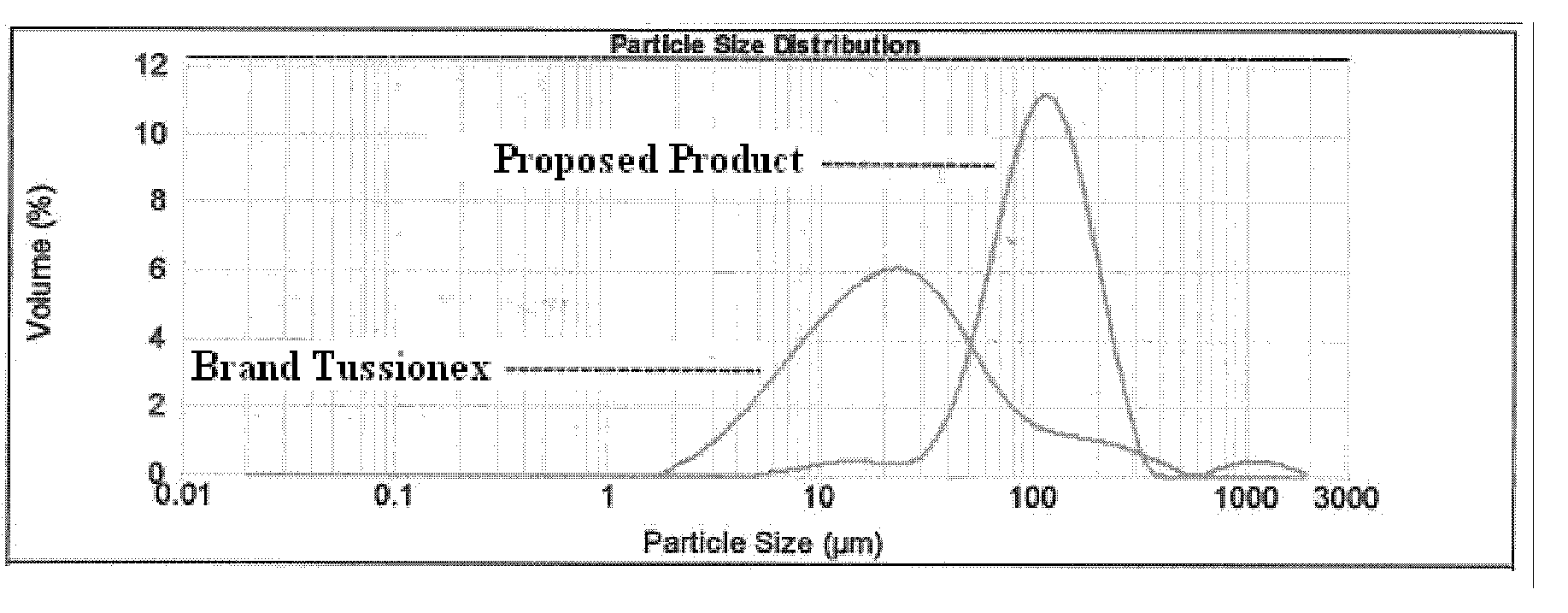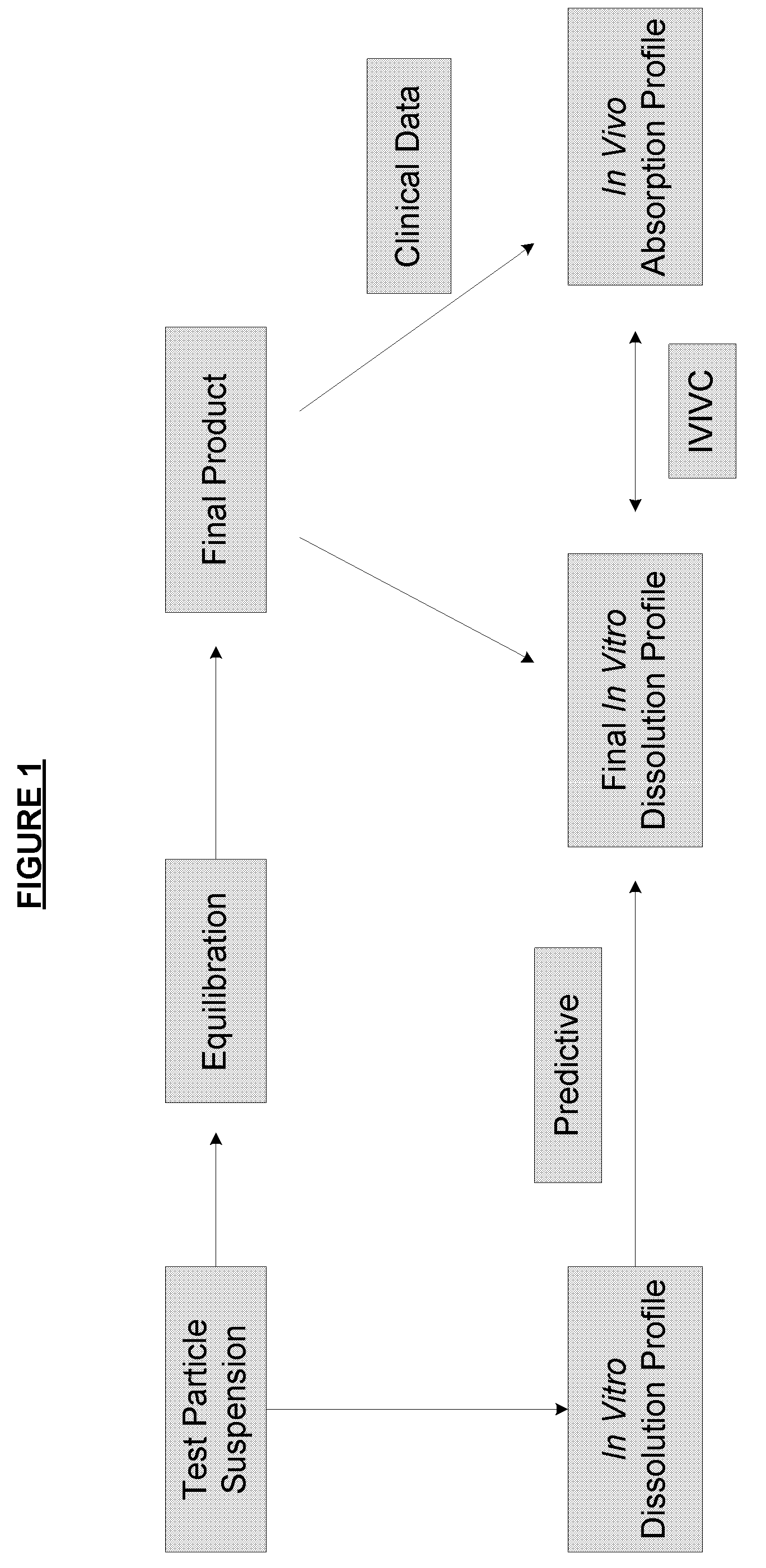Methods of formulating and designing liquid drug suspensions containing ion exchange resin particles
a technology of ion exchange resin and liquid drug suspension, which is applied in the direction of suspension, porous material analysis, and dispersed phase delivery, can solve the problems of limited success, poor control of drug release, and difficulty in achieving sustained release of drug from dispersed phase, so as to achieve the effect of maintaining bioequivalence and bioavailability or efficacy
- Summary
- Abstract
- Description
- Claims
- Application Information
AI Technical Summary
Benefits of technology
Problems solved by technology
Method used
Image
Examples
example 1
Dissolution Profile of Chlorpheniramine Polistirex Drug Substance
[0172]The dissolution profiles of hydrocodone polistirex and chlorpheniramine polistirex are considered. Hydrocodone polistirex resinate was prepared as described in U.S. Pub. Nos. 2007 / 0140983, 2007 / 0059270, and / or 2007 / 0148239. Chlorpheniramine maleate is bound to polistirex cation exchange resin. The resin was polistirex IRP-69 from Rohm & Haas for both drugs. A suspension containing both of these resinates in suspension was manufactured using the formula detailed in Table 1 and the process detailed in Table 2.
[0173]
TABLE 1Test FormulaIngredientIngredientApplicationPercentPurified Water, USPHydration Agent30.8%Ascorbic AcidpH Adjuster0.03%Propylene Glycol, USPSolvent3.33%MethylparabenPreservative0.13%PropylparabenPreservative0.04%Polysorbate 80Surfactant0.08%Xanthan GumThickener0.5%Vegetable OilViscosity Agent0.17%Liquid Orange ColorColorant0.002%D&C Yellow # 10Colorant0.002%Natural Mango FlavorFlavor0.03%Uncoated C...
example 2
Effect of Coating Level on Release Profile for Hydrocodone Polistirex
[0185]Batches of ethylcellulose coated hydrocodone polistirex resinate were prepared using three coating application iterations. Hydrocodone polistirex resinate was prepared as described in U.S. Pub. Nos. 2007 / 0140983, 2007 / 0059270, and / or 2007 / 0148239. The initial coating application was stopped when the coating level reached an initial low coating level (weight per weight basis), the second coating application added an additional coating to an intermediate coating level (medium), and the final application added an additional coating for a final coating level (high).
[0186]Separate suspensions of the coated hydrocodone resinates at each coating level were prepared according to the protocol of Example 1. Samples of each suspension were pulled after two months in storage and tested in USP Type II apparatus for dissolution testing. The dissolution media initially contained 900 mL of 0.1N HCl (i.e., pH of 1.2) for the ...
example 3
Dissolution Protocol Leading to In Vitro / In Vivo Correlation
[0189]A. Dissolution Results of Low Coating Level Hydrocodone Polistirex, High Coating Level Hydrocodone Polistirex, and Tussionex® Pennkinetic® ER Suspension Hydrocodone Polistirex with the Proposed Dissolution Procedure
[0190]Hydrocodone coating levels that bracket the Reference Listed Drug (i.e., Tussionex®) were determined by the results of in-vitro dissolution testing (as demonstrated in FIG. 8, which was a pilot batch). Suspensions utilizing hydrocodone resinate with a lower coating level and a higher coating level were selected.
[0191]Tussionex® antitussive-antihistamine suspension contains hydrocodone polistirex (sulfonated styrene-divinyl benzene copolymer) equivalent to 10 mg hydrocodone bitartrate and chlorpheniramine polistirex equivalent to 8 mg chlorpheniramine maleate. To prepare a suspension that is bioequivalent, batches were manufactured using the formula detailed in Table 1 and the process detailed in Table...
PUM
 Login to View More
Login to View More Abstract
Description
Claims
Application Information
 Login to View More
Login to View More - R&D
- Intellectual Property
- Life Sciences
- Materials
- Tech Scout
- Unparalleled Data Quality
- Higher Quality Content
- 60% Fewer Hallucinations
Browse by: Latest US Patents, China's latest patents, Technical Efficacy Thesaurus, Application Domain, Technology Topic, Popular Technical Reports.
© 2025 PatSnap. All rights reserved.Legal|Privacy policy|Modern Slavery Act Transparency Statement|Sitemap|About US| Contact US: help@patsnap.com



